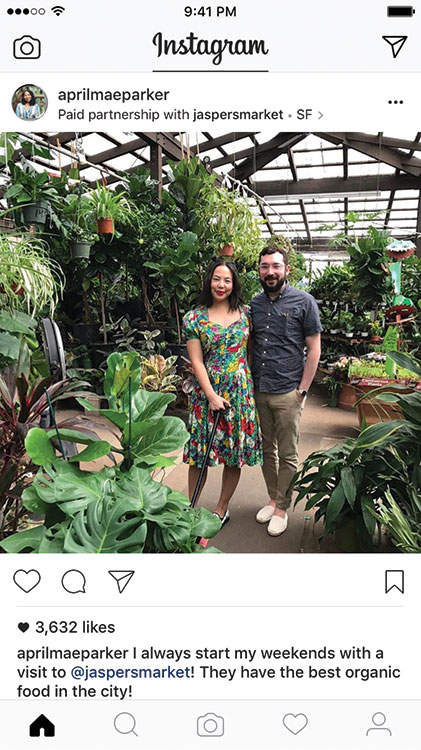November 14, 2018
How to Leverage Influencer Marketing
Influencer marketing is a flourishing new medium that gets results. Here’s how you can get in on the action.

PetSmart’s YouTube channel had grown stagnant. Puppy training videos simply weren’t generating the engagement they used to. That was a problem. Good engagement from new puppy owners could help compel those folks to shop at PetSmart. Get the pooch lovers buying at PetSmart at the start of their pet parenting adventure, and you potentially have long-term loyal customers.
Clearly, something was needed to bolster engagement. Enter August United.
The Tempe, AZ-based agency specializes in influencer marketing campaigns. Once engaged by PetSmart, Managing Director Tyler Farnsworth and his team devised an initiative that centered on partnering with YouTube influencer Aaron Burriss of Lazyron Studios. August United, Burriss and PetSmart collaborated to create a fun, entertaining and practical series of 10 puppy training videos. In a savvy move, the partners crafted the content to answer key questions related in top YouTube search terms for puppy training.
Housed on the PetSmart YouTube channel, the videos featured an engaging PetSmart trainer and Burriss, whose vibrant personality resonated with PetSmart’s desired audience of millennial-age pet parents. Burriss also posted behind-the-scenes vlogs, strong calls-to-action, and a clever scavenger hunt challenge to direct viewers to PetSmart’s channel to see the video series.
198%
The growth of Instagram influencer marketing in 2017.(Klear)
The campaign was a smashing success. As of late September 2018, there were more than 2.7 million views of PetSmart’s video series. Burriss’ behind-the-scenes vlog had tallied more than 465,000 views. In a December 2017 study, research firm Gartner found the video campaign was registering stellar organic visibility, appearing for 61% of key pet search terms. “The campaign combined the ideal influencer, engaging storytelling and helpful advice that new pet parents connected with,” says Farnsworth. “It really demonstrates the power of influencer marketing when it’s done right.”
Q: What is influencer marketing?
A marketing practice in which brands partner with individuals who have strong influence over audiences/prospects the brands want to reach. In return for compensation, the influencer engages in marketing activities that promote the partner brand to its audience. The promotion comes in the form of content – photos, videos, etc. – that the influencer shares via social channels.
Q: Why invest in it?
Strategic, well-executed influencer marketing campaigns can extend a brand’s reach with desired audiences, build credibility/social proof that prospects rely on in their purchase decision-making process, and aid in getting potential customers into a sales/marketing funnel, helping generate better bottom-line results.
“Influencers have the power to connect with audiences on a level that brands only wish they could,” says Emma Paye, influencer/content marketing manager at Hawke Media, a Santa Monica, CA-based digital marketing agency. “People are actively going to influencers’ channels and feeds, causing them to be exponentially more receptive to the content. These influencers can sway the sentiments of their online audience regarding a brand since they’ve already established their credibility.”
92%
of marketers who used influencer marketing in 2017 found it to be effective. (Linqia)
There’s an SEO benefit, too. “Search engine optimization is all about natural links, and those can only be earned,” says Paye. “When an influencer shares a link, it’s shared by others, and those others share the content even further.”
Additionally, influencer marketing could prove a cost-saver: High-quality visual content can be repurposed for other marketing mediums, including print and digital catalog spots.
Q: Sounds good, but is it really for me?
Yes. Firms ranging from megabrands to small businesses can benefit. “We work with everyone from Fortune 500 companies to boutique salons,” says Mae Karwowski, CEO/founder of Obviously, an influencer marketing firm in New York City.
Admittedly, smaller brands might not have the wherewithal to compensate a macroinfluencer – a person with a social following that numbers into the hundreds of thousands or millions. That is, unless the influencer simply loves the brand and wants to hype it. But that’s OK. Microinfluencers – social media personalities with engaged followings that can number as low as the hundreds – are also integral to powering successful campaigns.
Obviously provides a microinfluencer success story through its client Rogue House. For the Manhattan-based boutique salon, Obviously orchestrates a campaign that involves working with five to 10 microinfluencers per month. The influencers visit the salon for a free service – often hair-dyeing done in eye-catching colors like vivid blue and bright red. Loving the experience and results, the influencers post images of their fabulous hairdos. The evocative pictures grab attention on social, generating engagement.
“It really demonstrates the power of influencer marketing when it’s done right.”Tyler Farnsworth, August United
Even better, the campaign compels people from the influencers’ followings to become Rogue House customers. The business-driving results are a consequence of Obviously activating New York-based influencers whose audiences are replete with NYC residents who fit the salon’s target demographic. “Our client wanted to get more people walking through the door, and with the right influencers, we’ve been able to help them achieve that,” says Karwowski.
Q: OK, so how do I get started?
A grassroots method would have your internal marketing department scouring social platforms. The goal would be to identify influencers that appeal to audiences you want to connect with. From there, marketers would contact desired influencers, negotiate compensation, talk creative direction, track content production to ensure it meets agreed-upon terms, and formulate a means for analyzing ROI. While that can work, it can be labor-intensive and time-consuming – especially if you aim to undertake campaigns at scale.
There are, however, a growing number of tools and agencies that seek to facilitate effective, efficiently managed influencer marketing initiatives. For example, TapInfluence and Upfluence are tools that help marketers identify influencers, manage campaigns and analyze returns. Meanwhile, Mavrck is an influencer marketing platform that helps marketers discover and collaborate with influencers, advocates, referrers and loyalists to create authentic content and insights for customer experience touchpoints at scale.
84%
of microinfluencers charge less than $250 per branded Instagram post. (Bloglovin’)
Not be outdone, a firm like Obviously combines an influencer technology platform and a white-glove agency approach that handles all aspects of a brand’s influencer marketing experience. Services include identifying influencers, managing relationships with them, providing creative input on content, handling the logistics of scheduling and shipping products, analyzing ROI and more. Similarly, Farnsworth’s August United will help you find the right influencers, develop campaign concepts, and maintain guardrails to create a sustainable influencer marketing strategy.
Bottom line: There are potential partners out there. Understand what exactly they do, what they charge, vet them carefully and consider using them.
Q: How can I succeed with an influencer marketing campaign?
1. Have the requisite infrastructure in place. Before delving into influencer marketing, make sure you have a strong website, a solid approach to social media, a system for capturing and nurturing leads, and the product and service quality to meet the expectations prospects will come to you with, says Farnsworth. “Influencer marketing is a powerful way to augment your marketing strategy, but it’ll only be valuable if you’re able to capitalize on it, and you need those other things in place to do so,” Farnsworth says.
99%
of influencers say they’re active on Instagram, making it the most popular channel for influencer marketing. (#HASHOFF)
2. Know your budget. Sure, it would be nice to have Kendall Jenner plug your company to her 95 million or so Instagram followers, but a post from Kendall is probably out of most brands’ price range. Which is to say: Know what you’re able to commit to in terms of compensation and establish a budget that won’t break the bank while being ample enough to generate the realistic returns you’re after. “Your incentive budget will determine what you can do with your activation,” says Liz Gottbrecht, vice president of marketing at Mavrck.
3. Partner with the right influencers. The “right” influencers are social media personalities whose general image and content coalesces nicely with your brand, and whose audience is one you want to reach. Of course, this implies that you first understand your brand and know how you want it to be perceived and your desired audience and goals for each campaign.
Armed with this knowledge, begin honing in on influencers. As you do, focus on more than subscriber/follower numbers – look at engagement, too. A microinfluencer who has fewer followers than another but much greater engagement could be more effective for you, assuming each influencer is speaking to the prospects you’re keen to court.
“It’s essential to work with influencers who are authentic – who’ll bring enthusiasm to your brand and collaborate with you for the long-term to bring value to multiple parts of your organization,” says Gottbrecht.
70%
of influencers in 2017 were active on Facebook, 47% on Snapchat, 42% on Twitter, 38% on YouTube and 27% on Pinterest. (#HASHOFF)
4. Negotiate terms. Compensation isn’t just about cash. Influencers often work in exchange for free services, experiences and products. That presents opportunity for promotional products firms, which can potentially provide influencers with a certain amount of free/discounted swag that bears the influencer’s branding. Influencers can, for example, promote the distributor and the awesome merch/service they provided in their posts, while simultaneously promoting their own brand with the swag. “There’s a real need for swag that brands in your industry can leverage,” says Karwowski.
Ensure influencers understand how many posts/content pieces are expected over a defined period of time in return for the agreed compensation. Define, too, whether compensation is something set in stone, or based on performance metrics – for example, influencers receive “X” in exchange for generating a certain amount of impressions.
5. Provide a creative brief. The brief should communicate to influencers goals for each activation, but that’s not all. “It should contain elements like things to avoid, and things to emphasize,” says Farnsworth. The brief can provide creative direction, including suggestions on approaches to take and even visuals of sample posts. Still, the brief shouldn’t be a rigid dictum. Give influencers room to exercise the creativity that has made them successful social media personalities.
6. Measure the results. Once a campaign concludes, it’s essential to analyze how it performed against your goals. Relevant metrics can vary based on an activation’s objectives. Still, things to consider could include: How many impressions did the campaign generate? What social platforms, if multiple were used, led to the greatest engagement and most impressions? Did influencers’ posts drive a desired number of people to your social platforms and/or website? How many new leads did you get?
Similarly, how many potential customers were you able to start moving through your sales funnel based on the campaign? Did the initiative lead to a desired number of new followers on your Instagram page or YouTube account? If it’s all about sales, consider having influencers use affiliate links to pages you’re trying to advertise to help with sales tracking.
12%
of influencers planned to make YouTube their top platform in 2018, up from 3% in 2017.
7. Foster relationships. If analysis shows that certain influencers helped drive good results on a campaign, expand the partnership and try to work with them consistently. Recognize, too, that they’re not ad space – they’re people. Treat them as such, perhaps sending handwritten thank-you notes and maybe a bit of extra free swag.

FTC rules require influencers to be upfront about partnerships.
8. Beware of influencer fraud. This occurs when pseudo-influencers do things like artificially inflate follower numbers to make it seem like they have far-reaching influence when they do not. Be sure to carefully vet potential partners.
Q: Alright, I’m in. Are there regulations I need to know about?
Yes. The Federal Trade Commission requires influencers and brands to make it obvious that an influencer is being compensated. Fortunately, this can be as easy as influencers using hashtags like #ad or #sponsored in their posts. If that feels spammy, the FTC also says it should be acceptable to provide a hashtag like “#XXPartner,” wherein the “XX” is the brand name. So for example: “#ASIPartner.”
Also, Instagram has a special branded content option that places a header over a post saying it was paid for by whoever the sponsor is. As you pursue partnerships, ensure influencers understand they must make it evident that they’re being compensated for each post they put up.
Predictions for the Future of Influencer Marketing
1. The Practice Will Grow as Social Platforms Exert Greater Marketplace Power. “Our business tripled in 2017 and it’s tripling again this year,” says Mae Karwowski, CEO of Obviously, an influencer marketing agency. “In 2019, our clients are devoting larger portions of their budgets to influencer marketing.”

[From left] Mae Karwowski, Obviously; Emma Paye, Hawke Media; Liz Gottbrecht, Mavrck
2. Authenticity Will Become Paramount. “As more brands leverage influencers, consumers are going to be more skeptical of paid partnerships,” says Emma Paye, influencer/content marketing manager at Hawke Media, a digital marketing agency. “Brands will need to work collaboratively with influencers to make sure their content remains sincere.”
3. More Influencers Will Leverage YouTube and Pinterest. A study from content marketing firm #HASHOFF found that 12% of influencers intended to make YouTube their top platform in 2018, up from 3% the year before. Meanwhile, in September, Pinterest extended its content marketing API to third-party influencer marketing platforms. That came after Pinterest released redesigned business profiles in April and a June creator conference in which company leaders invited 250 influencers to Pinterest’s San Francisco offices.
Relatedly, Pinterest is increasingly intriguing experts in the influencer marketing field because pins have greater longevity than certain other content, such as Instagram posts. “We’re investing more in Pinterest because we believe in the long-tail impact of influencers’ Pins to drive brand value, and we expect others will do the same,” says Liz Gottbrecht, vice president of marketing at Mavrck, an influencer marketing platform.
4. Long-Term Relationships Will Increasingly Replace One-Off Collaborations. “Brands will start partnering with influencers as brand ambassadors in order to establish credible, genuine relationships,” says Paye. “Influencers in turn will feel more respected, valued and incentivized to produce quality work.”